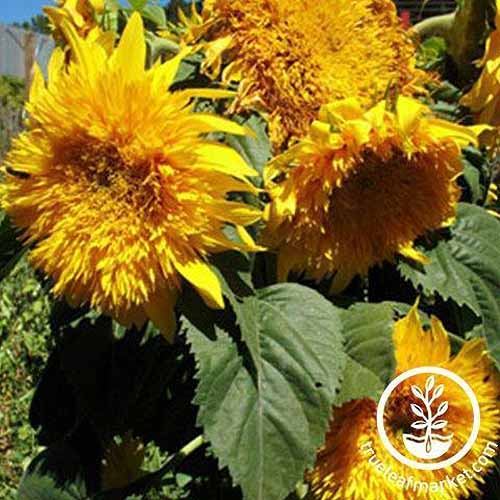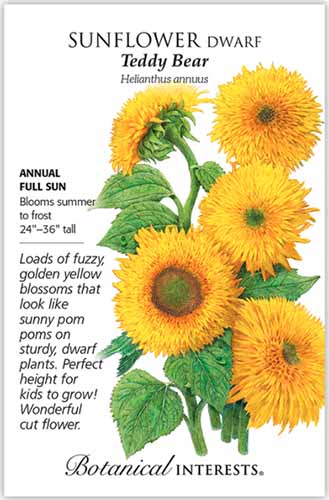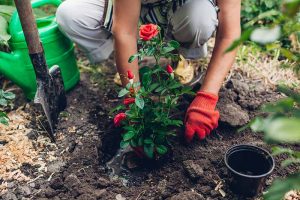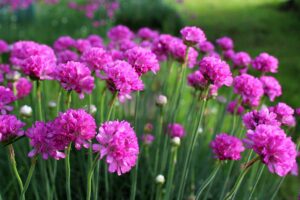If sunflowers have always seemed out of reach for you, how about growing them in containers?
You may have assumed that only those with big garden plots, or perhaps a field out back, would be able to plant their own Helianthus annuus.
But this is simply not true! Many varieties of this super-bright and alluring flower will grow just fine in pots or planters.
Dwarf varieties, the ones that attain 12 inches to three feet or so in height, are the natural selection for pots, but it’s even possible to grow mid-size sunflowers with this method.
I’m speaking of the ones that produce blooms six or more inches in diameter, and grow four to six feet tall.
To grow them in pots – very big ones – you’ll need to be extra dedicated to the process to get them to bloom on your patio, deck, or sidewalk.
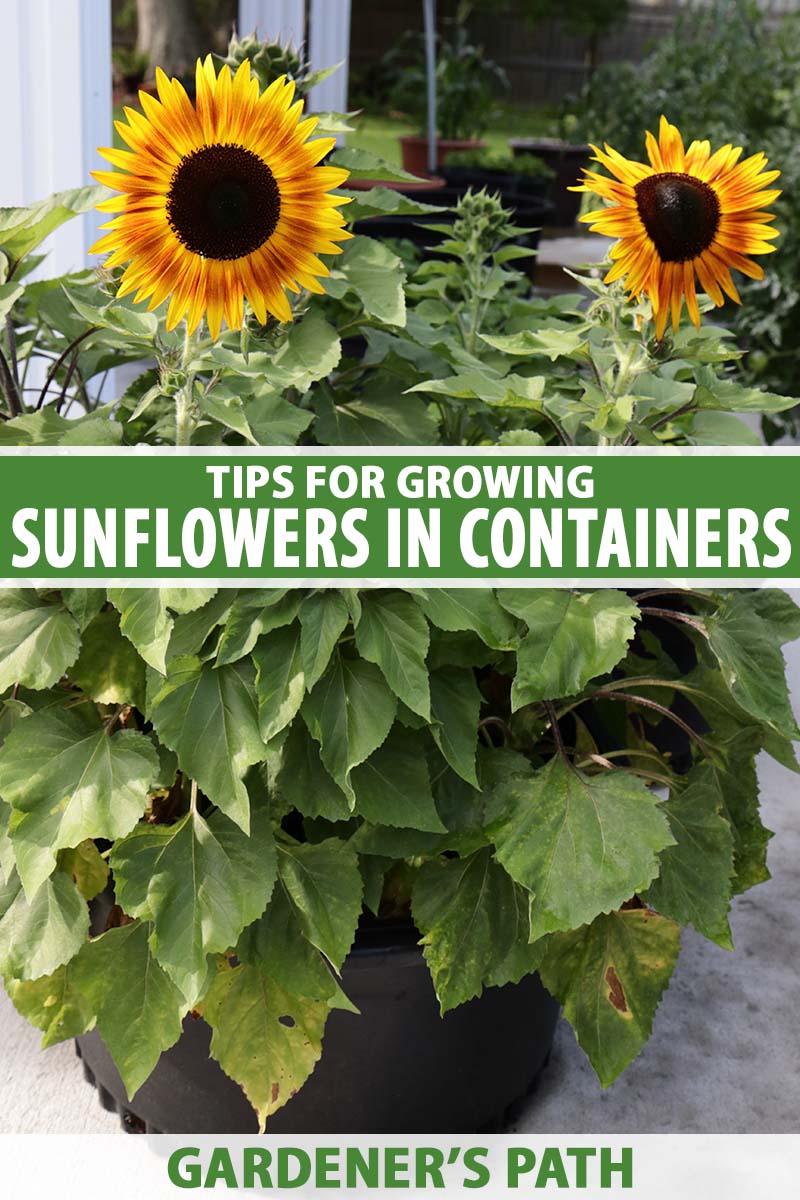
We link to vendors to help you find relevant products. If you buy from one of our links, we may earn a commission.
I’m going to take you through the steps of selecting a variety to grow and the container to grow it in, along with the best ways to care for potted sunflowers throughout the growing season.
Before we proceed, I’d like to encourage you to see this as a separate opportunity from planting the towering varieties in a garden plot or field, not a second-best choice because you can’t have the “real” thing.
This is a wonderful way to grow a splashy, pollinator-friendly, inexpensive plant, not a meager substitute for long rows of tall stems with giant seed heads.
Container-grown sunflowers are valuable as cheery, compact day-brighteners with vibrant, sunny blooms.
And this growing technique presents so many advantages, from having sunflowers in areas with a short growing season to being able to readily tend and protect your seedlings.
Plus, you can move the containers around to tap into available sunlight or avoid too-cool weather, or you can move the whole kit and kaboodle when you move to a new household.
Want to learn more? Let’s delve further into this topic.
Here’s what I’ll cover:
What You’ll Learn
The Best Container Sunflowers
When it comes to planting anything, but especially annual flowers, I am the last one to want to discourage any gardener.
So I’ll tell you that yes, it is technically possible to plant mammoth sunflowers in containers.
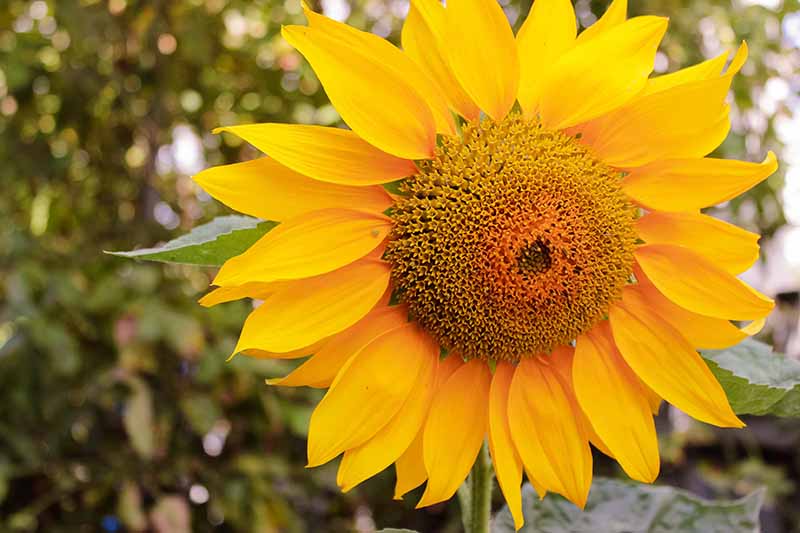
But please note that in gardens, these H. annuus cultivars like ‘Mongolian Giant’ can grow 10 feet tall, and send taproots down six or more feet deep!
You could grow them, but it would take a 10-gallon pot, constant watering, a hefty support, and maybe a fence or table to prop the pot against.
That would be lots of work, but like I said, I won’t try to discourage you if that’s what you want to do.
If you still want to grow one that’s tall, but you can live without it being downright huge, a pot is a decent option for a mid-size variety like ‘Taiyo,’ which reaches about five to seven feet tall.
You could grow one (just one!) in a five-gallon pot with a trellis, stake, or tomato cage in place for support.
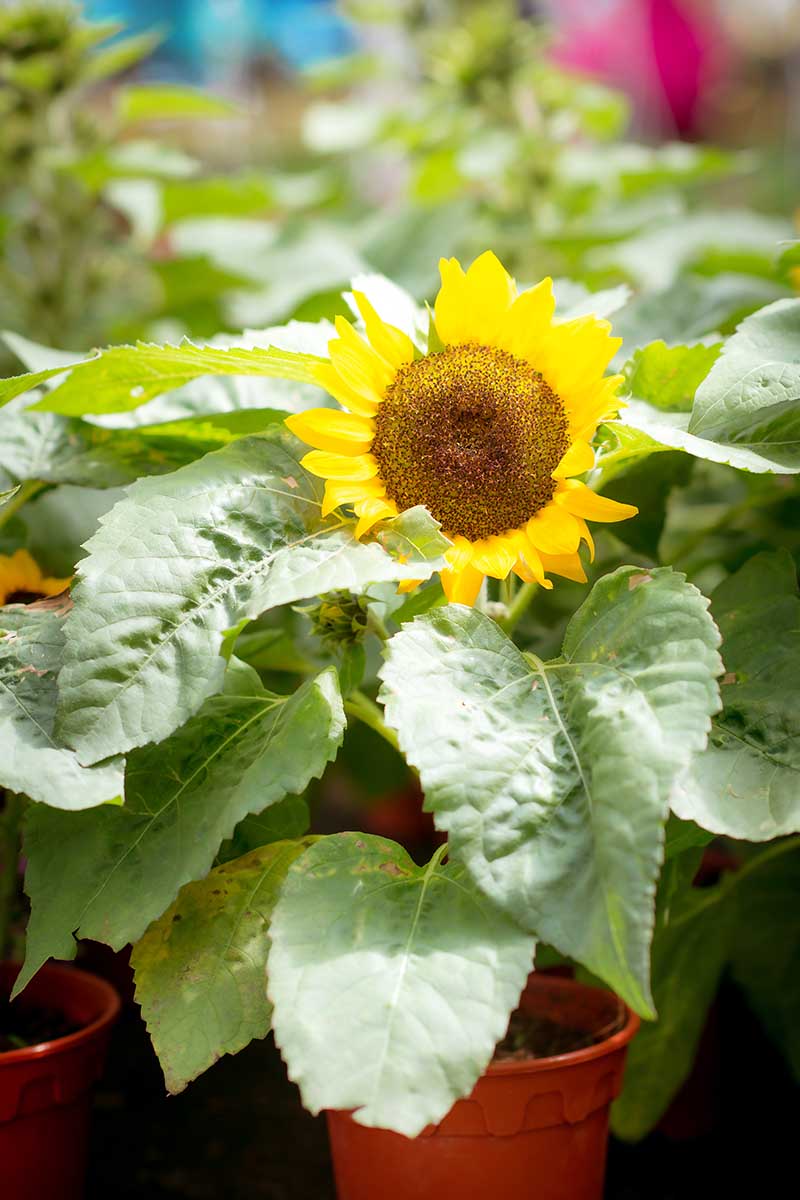
Now I’m going to amp up the encouragement, as we talk about dwarf varieties.
The sunflowers that are low-growing, reaching somewhere between 12 inches and three feet tall, are ideal for containers.
They don’t usually need any support, and you can grow one plant in a six-inch pot, or three in a gallon-size container.
An interesting note here: The dwarf varieties will not get as large when they’re planted in pots.
‘Sunny Smile,’ for example, will grow to only 10 to 15 inches tall in a planter, while it will reach 12 to 24 inches tall when planted in the garden.
‘Sungold Dwarf’ is another good choice if you don’t already have something in mind.
It reaches about 18 to 24 inches in a container (24 to 36 inches in a raised bed or garden) and seeds are available in various-sized packets from True Leaf Market.
There are a few other considerations when you’re choosing the best variety to grow.
Keep in mind that any single-stem varieties will provide just one flower per pot. If you’re growing so you’ll have a source for floral arrangements, you may want to opt for a branching type instead.
Several dwarf types produce multiple blooms on each stalk, like ‘Teddy Bear,’ which is available from Botanical Interests in one-gram seed packets.
I’d also steer you away from growing the perennial types of sunflowers in containers. While they have a beauty all their own, and usually bloom for a long time, they also tend to spread.
This is a problem for maintaining air circulation and an ample water supply, as the clumps grow ever bigger.
To grow healthy swamp sunflowers, for example, you’d need a pot with a capacity of at least 25 gallons or larger, which can become quite heavy and cumbersome.
And it’s quite easy to let the pots get too dry in the late fall or early spring, when you’re not doing as much gardening.
To me, keeping up with the perennials in pots is a lot of extra work for a plant that grows so much more easily in a native planting, and that has shorter stems so it isn’t an obvious choice as a cut flower.
Container Considerations
Here’s what to look for in an ideal container: A lightweight planter that’s at least six to eight inches deep and 10 inches wide, and that already has drainage holes in the bottom.
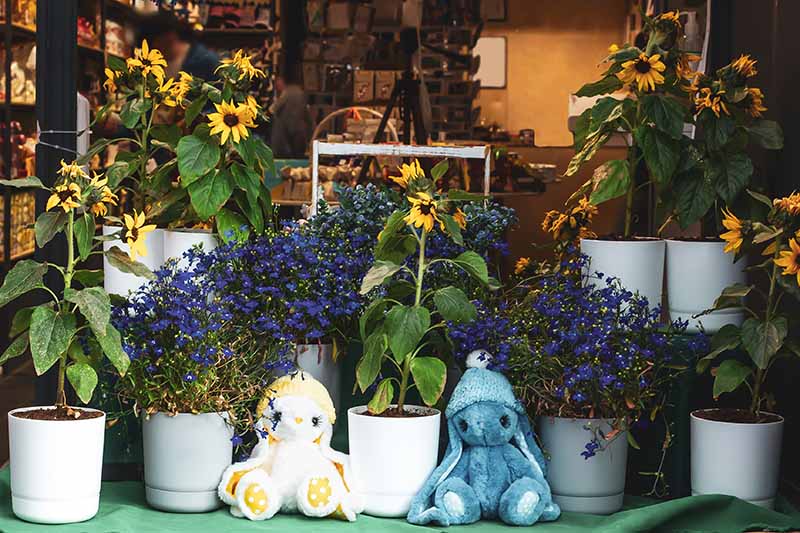
It should also be constructed of a material that will help the soil stay moist, like glazed terra cotta or plastic.
When you opt for plastic, keep in mind that black plastic can increase the soil heat to the point where the plants may wither. Green is better.
You might also want to consider using fabric “grow bags.” They are lightweight and reusable, and retain moisture.
These five-gallon cloth aeration containers from Garden4Ever and available via Amazon are a good option.

Another decent option is containers with all the right dimensions that you’re able to readily poke or drill drainage holes into.
Options here include plastic buckets, metal pails, or large plastic food containers like the ones Costco potato salad comes in.
On the other end of the scale, some pots won’t work for this project at all. This category includes the ones that are both deep and super heavy, like 25-gallon ceramic pots, since they’re tough to move once they’re filled with soil.
If you’re planning to plant in a container that can’t be shifted, I’d recommend a small, more shallow raised bed in place of a heavy pot. It will take less soil and less water to fill and maintain, while giving you more surface space for your flowers.
Also avoid terra cotta that hasn’t been glazed. While sunflowers can grow without too much water, unglazed ceramic planters dry out way too fast.
Bear in mind that these plants will only grow and bloom where they receive direct sun outdoors, or significant sunlight or grow light exposure indoors, and that warmth dries the soil quickly.
There are also a slew of container types that aren’t ideal, but that you could make work if you already have them in your possession or a certain pot or bowl has sentimental value.
For example, if you’d like to plant a sunflower in a vintage teapot that doesn’t have drainage holes, consider placing a more suitable container inside.
Planting in a pot with good drainage enables you to use a larger undrained decorative cachepot of your choosing.
You can also use unglazed clay pots if you’re willing to water more often, or opt for great big pots and invest in a plant caddy so you can transport it readily.
Just be sure to calculate the weight of the heavy or large planter when it’s full of soil, water, and sunflowers before purchasing a plant caddy to suit.

One option is a dolly that can sustain 440 pounds, like this one that’s available via Amazon.
How to Sow
Sunflowers do best in soil with the same pH range as what’s preferred for growing most vegetables, between 6.0 and 7.5, though they’ll cope if the pH is as low as 5.5.
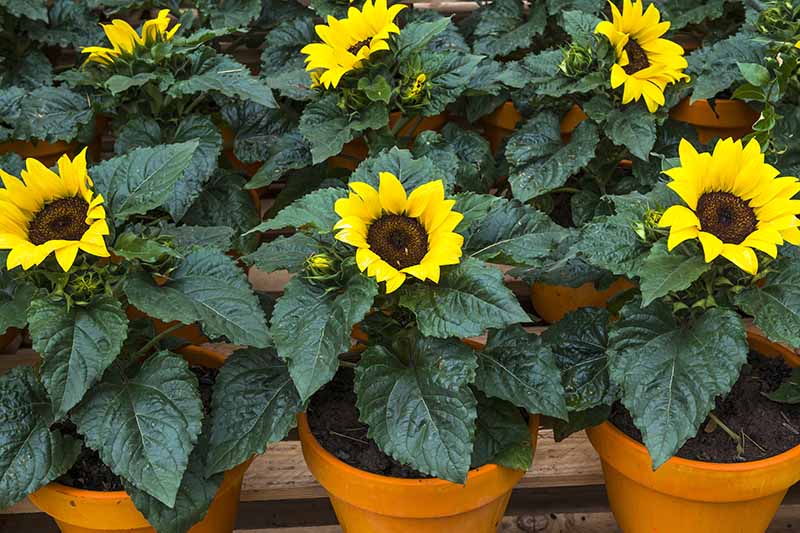
Your soil choice is crucial. You want it to be light and well-draining, but to also have enough nutrients to see the sunflowers through most of the season.
I like to use a premixed growing medium labeled for vegetable gardening, and mix in a couple of handfuls of well-aged compost, either store-bought or from my own pile.
If you use this type of mix, your soil will drain well on its own. Don’t add sand or pebbles as a bottom layer in the pot in lieu of well-draining soil.
That used to be a commonplace container gardening technique, but now we know that kind of “drainage material” can actually make it difficult for the soil to drain properly.
Poor drainage from pebbles in the bottom of a planter may encourage mildew and certain types of root rot because the roots don’t get adequate aeration.
Before sowing, fill the pot up to two-thirds of its height, re-moisten the growing medium and compost mix, and let any excess water drain out of the holes.
Then, carefully place the seeds at an appropriate distance – four inches apart for dwarf varieties, or one seed per 12-inch diameter five-gallon pot for mid-size single-stem types.
If you like, plant two seeds in each space and then thin to the strongest seedling when they reach three or four inches tall.
Cover the seeds with about half an inch to an inch of the same growing medium, following the instructions on your seed packet. Tamp the soil lightly with your clean or gloved fingers, and water the seeds in.
They will germinate within one to two weeks, and you should keep the soil moist but not waterlogged that entire time. If they receive too much water, the seeds will rot.
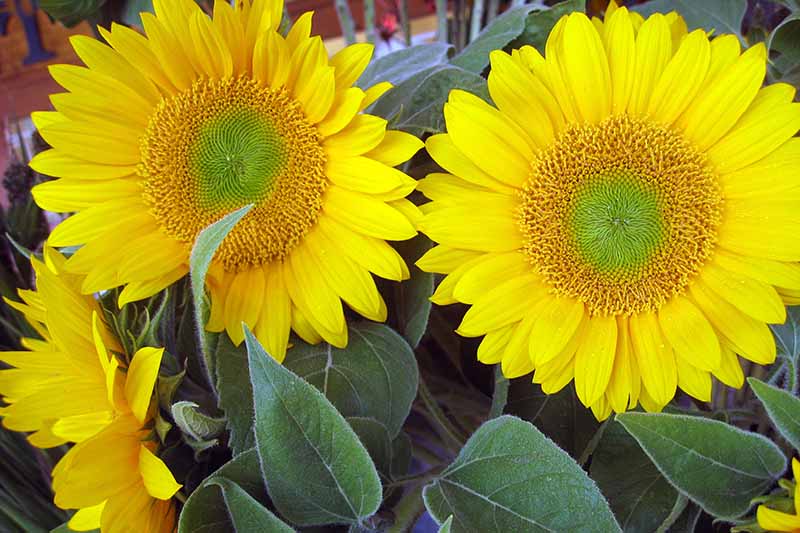
If you’re starting the seeds indoors before transplanting to your selected pots, move the seed-starting tray or peat pots to a sunny windowsill as soon as they sprout.
You may need to rotate the seed-starting container indoors so that the seedlings grow straight, instead of curving towards the sun.
For outdoor seedlings, you may want to place a row cover over them once all the seeds in the container have germinated, to discourage birds and squirrels from snacking.
While the plants are still small, also make sure to check if they’re receiving enough sun, and adjust their location if they’re not.
If you plan to try to grow them indoors all the time, make sure to move them somewhere that they’ll get sufficient sunlight.
This is the extra tricky part when attempting to grow sunflowers indoors. They need lots of light, but if you place them on a windowsill with direct sunlight, it can dry them out quickly, so you’ll be watering constantly.
And the windows may also allow for exposure to drafts or cooler temperatures, which can make H. annuus languish.
To increase the odds of success if growing indoors is your only option, choose the dwarf varieties that won’t need as much water to grow.
Also consider investing in a grow light so they don’t have to be so close to drafty windows, and growing them in small pots you can move outdoors to take advantage of bright, warm days.
It’s a good idea to pick a pollenless variety to grow if you’re trying to complete the season inside.
Even though all H. annuus varieties can ordinarily self-pollinate, most of them do better with insect pollination, especially during stressful times.
How to Grow
Especially if they’re right there on your porch, patio, or balcony ledge, it’s a lot of fun to watch these plants grow before your eyes.
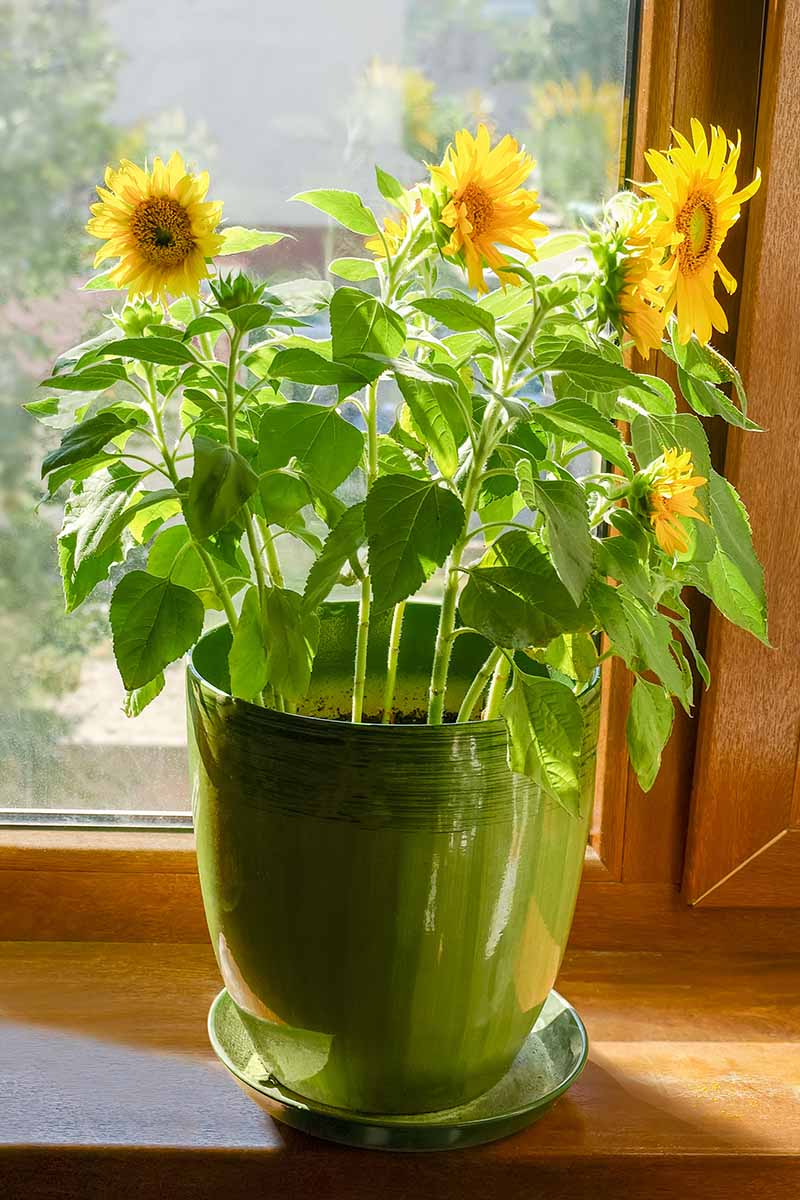
Here’s what you’ll need to do to encourage them:
Staking
When you have planted a variety that will attain a height over four feet tall, it will need support early on.
Bamboo stakes are one good option, like the four-foot natural version sold in 25-stake packs via Amazon.
Another option when you’re growing taller sunflowers in pots: Plan to place the containers along a fence, and gently tie the stems to the fence with a loop of sisal twine.
This option does eliminate your option to move the pots in inclement weather or for better sun exposure, so you’ll need to plan around that.
Place any support that’s going in the pot or in the ground nearby as soon as you see that a seed has sprouted and will become a viable plant.
It’s so much easier to do this at the start than trying to place a stake or tomato cage after the roots have formed.
If the cage doesn’t completely surround the plant, you may need to gently tie the main stem to the support once it’s six inches tall.
Use sisal twine or loops of cotton or nylon fabric for this task, and tie the stems so that they still have four inches between them and the supports.
You don’t want the plants to get knocked over by a gust of wind, but you don’t want to restrict air circulation or cut into the stem while trying to prevent them from toppling either.
And if you notice that your single-stem dwarf varieties need support later in the season,16-inch plant supports with a curved top that encircles the stem will usually work.

If you’ve spaced the flowers at least four inches apart, it’s simple to install these supports later on, without damaging the roots. They’re available in 10-packs from ODOXIA via Amazon.
Watering
Beyond staking, if necessary, assuring they receive enough sun but don’t get too dry is the key to healthy plants that produce blooms.
Ideally, the rain will provide some water, but you’ll quite likely have to supplement.
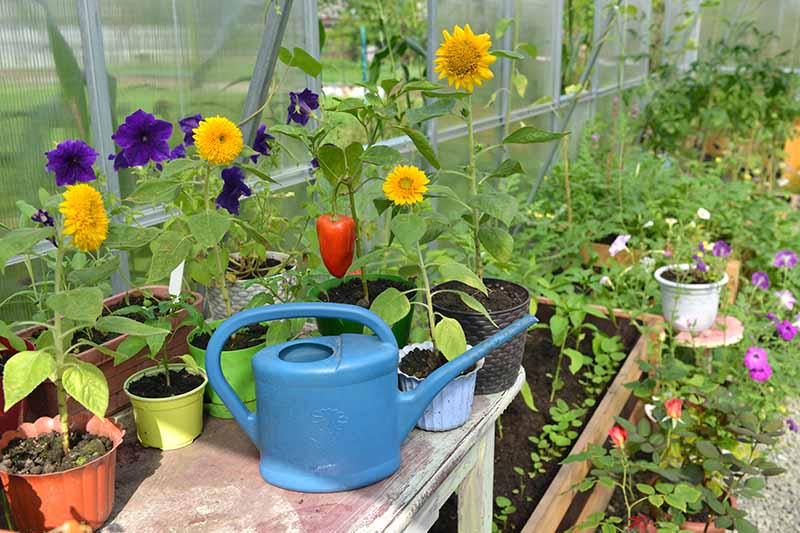
Water deeply but infrequently, giving the soil a chance to dry out to at least an inch down in between drenchings.
Water the seedlings about four inches away from the main stem, starting when they sprout.
Take particular care that your seedling receives a watering about 20 days before flowering so the roots will grow strong, able to help the plants support their blooms.
Check your seed packet under “days to maturity” for the timing on this.
If you’re planning to save seeds later, it’s also important to water again about 20 days after flowering, to encourage healthy roots that will help the plants receive the nutrition they need to form seed heads.
And if you have planted a branching variety, keep up this infrequent, deep watering until the last blooms have formed.
Make the moisture last longer by mulching the seedlings with a couple of inches of straw once they reach four inches tall.
Just be careful not to place any mulch within two inches of the center stem. It’s very easy for soil- or water-borne fungi and other pathogens to jump from wet mulch to the plants, so don’t provide a path by mulching too close.
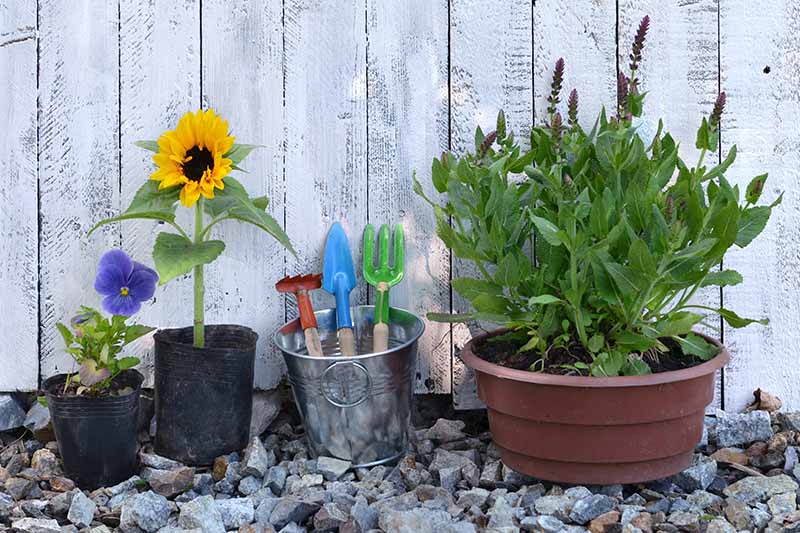
Also find a watering can with a long spout, or a hose without a spray nozzle, to use to water at the soil line.
When you water overhead with spray, you may promote disease via wet leaves, and you also risk not having enough water reach the soil and roots.
To know when to water, stick your finger into the soil about four inches from the main stem. If the soil is dry to the touch an inch or so down, it’s time.
You’ll want to give each pot a quart to a gallon of supplemental water at a time, depending on its size.
Be sure to allow any excess water a good 15 minutes to drain, and then pour off any excess from the tray or cachepot below the container.
This is especially important if you’ve placed a pot with drainage holes inside a larger pot that doesn’t have drainage.
You don’t want standing water beneath your sunflowers, or anywhere in your growing area, since it encourages mildew diseases and insects like mosquitoes.
Make sure to dump extra water from those trays after heavy rains, too.
Fertilizing
If you planted in nutritious soil with plenty of aged compost, you probably won’t need fertilizer.
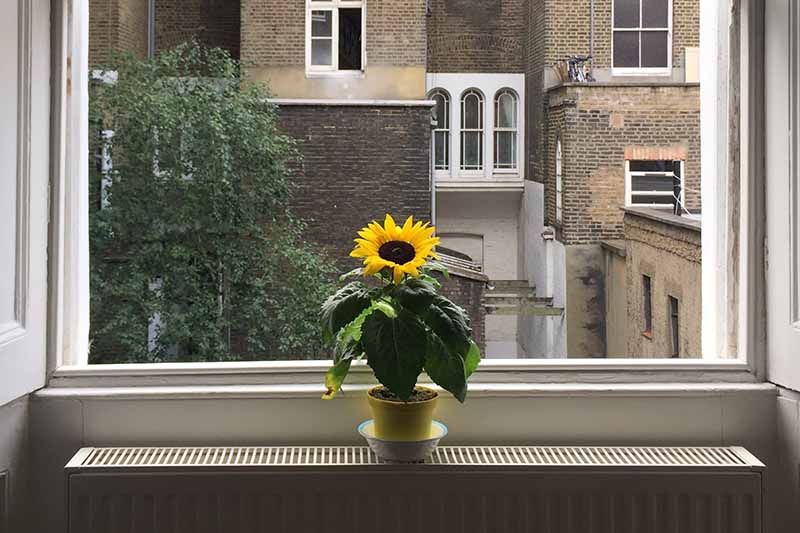
Some experienced home gardeners do add some balanced fertilizer to the pail when they water, following the manufacturer’s instructions.
This offers a nice boost if you feel like the soil has leeched some of its nutrients due to frequent waterings, but I wouldn’t do it more than once in a growing season.
Picking
Containers give you the option to bring the whole blooming pot indoors at its peak, or to grow blooms you can pick for floral arrangements.
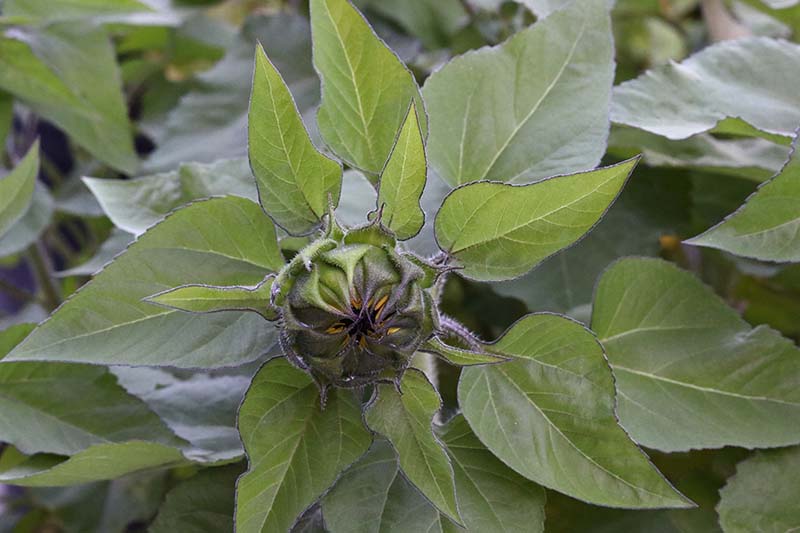
Pick the blossoms to bring indoors when the flower heads are just starting to show color. Strip any leaves from the lower part of the stalks before placing them in water to complete blooming.
Bear in mind if you’re growing a single-stem variety, once it blooms and you pick it, that’s it for the season.
That’s one of the reasons I prefer to plant branching dwarf varieties in pots. They’ll bloom continuously for weeks, providing either a beautiful decoration in the pot, or plenty of stems for compact flower arrangements.
For the branching types, clipping individual stems won’t encourage more blooms, but it does make the plant look tidier.
Growing Tips
- Plant one dwarf sunflower seed per six-inch pot, or three in a one-gallon pot.
- Make sure the plants receive full sun outdoors or significant light indoors.
- Plant in well-draining soil.
- Place pots where they’re protected from strong winds.
- Add mulch to the pots to suppress weeds and retain moisture.
Managing Pests and Disease
Just like all sunflowers, most of the ones grown in containers will grow without encountering many pests or diseases.
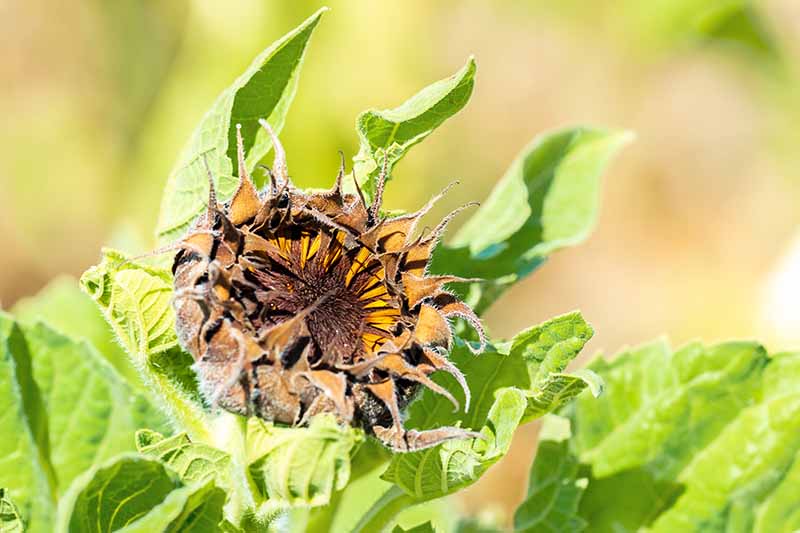
Squirrels and birds probably pose the biggest threat. But it’s far easier to protect potted plants than the ones that are growing in the garden if you do have issues.
You can conveniently toss a row cover or protective netting over a couple of pots versus trying to protect vast spaces.
Rabbits can also be an issue, but you can literally move containers out of harm’s way. Placing them on a table or wall, or on top of a cinder block, will make it hard for rabbits to reach them.
This growing method also makes it much simpler to eye individual plants and blooms for insect pests and take steps to eradicate them.
They’ll be closer to your home, and perhaps nearer to eye level. And they won’t have weeds or other flowering plants growing right next to them, competing for your attention.

A few of the pests that might infest H. annuus include cutworms when they’re seedlings, stem weevils as they get larger, and midges and lygus bugs in the weeks when they’re flowering or forming seeds.
Learn more about sunflower pests in our guide, which also delivers tips for coping with them.
As for disease, be on the lookout for downy mildew, rust, and powdery mildew.
You can prevent them by making sure your plants have ample air circulation, and always watering at the soil line, not from above, so pathogens aren’t spread via wet leaves.
Even though it’s kind of a pain to water container sunflowers so often, growing them in well-draining soil and in pots will help you to avoid two other possible diseases: Phoma black stem, caused by the fungi Phoma macdonaldii, and phomopsis stem canker, caused by Phomopsis helianthi.
Either will turn the stems black and make your sweet sunflowers wilt, but both are readily avoided by selecting resistant cultivars, spacing the plants properly, and never allowing the soil to get waterlogged.
Learn more about drooping sunflowers in our guide.
Plant Your Own Pot of Gold
When you love H. annuus and its fellow perennial sunflower varieties as much as I do, there’s no such thing as too many growing options.

I haven’t quite reached my bucket list goal of growing a whole meadow of these bright beauties, but maybe someday!
In the meantime, it’s nice to know I can grow them in a row in the middle of the vegetable garden, in the ground beneath my mailbox, in a flower border, and yes, in containers!
If you’re also a fan and have some experience with planting sunflowers in containers, how about sharing some of your tips and questions in the comments section below?
And for more information about growing these cheerful flowers, check out these sunflower guides next:
